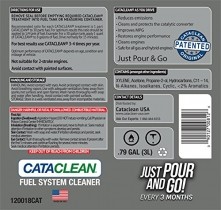Experiencing the dreaded P0430 code, specifically on Bank 2, can be frustrating for any car owner. This code signals that your catalytic converter’s efficiency is below the required threshold, and it often leads to questions about what’s gone wrong and how to fix it. Recently, I encountered this very issue after using regular gas from Costco. My truck was idling for a while in humid, rainy conditions, and I soon noticed my gas mileage had dipped to an abysmal 14 mpg in the city, usually around 16 mpg. I suspected the cheaper gas might be the culprit pushing my emissions system over the edge and triggering the P0430 error.
Before diving into solutions, it’s important to understand what the P0430 code means and why “Bank 2” is significant. The P0430 code, in general, indicates “Catalyst System Efficiency Below Threshold (Bank 2).” Your car’s engine is typically divided into “banks,” and Bank 2 refers to the side of the engine opposite to cylinder number 1. This code means the downstream oxygen sensor on Bank 2, located after the catalytic converter, is detecting that the converter isn’t cleaning exhaust gases as effectively as it should. Addressing issues on Bank 2 specifically means focusing on the catalytic converter and related sensors on that particular side of your engine.
My first step after the P0430 code appeared was to reset it using an OBD scanner. Hoping for a quick fix, I decided to try a fuel system cleaner, opting for Cataclean.
Cataclean is designed to clean fuel and exhaust systems, and I used the 3L gas version. Following the instructions, I split the bottle into two treatments, each with about half a tank of premium regular gas from Shell, assuming better quality fuel might aid the cleaning process. While the truck did seem to run smoother afterwards, the P0430 code frustratingly reappeared after a few drive cycles. Cataclean, in my experience, provided only a temporary reprieve.
Since chemical treatments didn’t solve the problem, I moved on to a more mechanical approach: installing an O2 sensor non-fouler on the downstream oxygen sensor of Bank 2. A non-fouler essentially spaces out the O2 sensor from the direct exhaust stream. The idea behind this is to reduce the sensor’s sensitivity to exhaust gases, potentially tricking the system into thinking the catalytic converter is working efficiently enough to keep the P0430 code at bay.
Installation was straightforward and relatively inexpensive. I purchased a non-fouler online and, to make the job easier, also used an oxygen sensor socket and copper anti-seize lubricant.
The O2 sensor socket made removing the old sensor much easier, and applying copper anti-seize to the threads during reinstallation prevents future seizing. What surprised me most wasn’t just that the P0430 code vanished and hasn’t returned even after over 1000 miles of driving, but my gas mileage also saw a noticeable improvement. It jumped from the pre-Costco gas 16 mpg city driving to around 18 mpg after installing the non-fouler. Using the Fuely app, I’ve meticulously tracked my fuel economy, confirming this positive change.
While I primarily aimed to eliminate the P0430 code, the improved gas mileage was an unexpected bonus. It begs the question: how can an O2 sensor non-fouler, essentially a workaround for sensor readings, lead to better fuel efficiency? One possible explanation could be that by resolving the fault code and ensuring the system isn’t running in a limp mode or with incorrect fuel trims due to sensor misreadings, the engine management system can operate more optimally, thus improving fuel economy. However, the exact mechanism remains somewhat unclear.
In conclusion, for my P0430 Bank 2 code issue, the O2 sensor non-fouler proved to be a successful and surprisingly beneficial DIY fix. It’s important to note that this approach addresses the symptom (the code) rather than the root cause of potential catalytic converter inefficiency. If your catalytic converter is genuinely failing, a non-fouler is a workaround, not a permanent repair. However, in cases where the code might be triggered by sensor sensitivity or minor fluctuations, it can be an effective and affordable solution, potentially even leading to unexpected improvements in fuel mileage.
